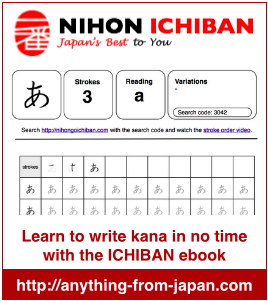The Japanese written language consists of a combination of three types of characters. To a lesser extend it nowadays also uses some Latin alphabet for abbreviations and numbers.
1. Kanji (漢字)
Kanji originally came from China to Japan. The term “kanji” literally means “Han characters” or “Chinese characters” and it is identical to the characters in China to describe their writing.
Kanji are mainly used to describe names and nouns. When used in verbs and adjectives they mostly are written in combination with hiragana. Most sentences include kanji as well as hiragana.
Japanese dictionaries list around 10,000 kanji. The Japanese government limited the kanji used in official publications to the 1945 touyou kanji with about 4000 readings. The Japanese Language Proficiency Test (JLPT) is based on these 1945 touyou kanji.
A Japanese with average education knows around 3000 kanji and it is estimated that around 4000 kanji are used in Japanese literature.
2. Hiragana (平仮名)
Hiragana is a phonetic alphabet that was developed in the ninth century to simplify writing. It nowadays is mainly used for native Japanese words. Hiragana are derived from more complex kanji and each hiragana represents a syllable. A total of 46 hiragana are used in contemporary Japanese writing.
List of the 46 hiragana and their 25 diagritics (with ゛or ゜)
| A | I | U | E | O |
| あ (a) | い (i) | う (u) | え (e) | お (o) |
| か (ka) が (ga) |
き (ki) ぎ (gi) |
く (ku) ぐ (gu) |
け (ke) げ (ke) |
こ (ko) ご (go) |
| さ (sa) ざ (za) |
し (shi) じ (ji) |
す (su) ず (zu) |
せ (se) ぜ (ze) |
そ (so) ぞ (zo) |
| た (ta) だ (da) |
ち (chi) ぢ (ji) |
つ (tsu) づ (zu) |
て (te) で (de) |
と (to) ど (do) |
| な (na) | に (ni) | ぬ (nu) | ね (ne) | の (no) |
| は (ha) ば (ba) ぱ (pa) |
ひ (hi) び (bi) ぴ (pi) |
ふ (fu) ぶ (bu) ぷ (pu) |
へ (he) べ (be) ぺ (pe) |
ほ (ho) ぼ (bo) ぽ (po) |
| ま (ma) | み (mi) | む (mu) | め (me) | も (mo) |
| や (ya) | ゆ (yu) | よ (yo) | ||
| ら (ra) | り (ri) | る (ru) | れ (re) | ろ (ro) |
| わ (wa) | を (wo/o) | |||
| ん (n) |
The combination of some of these hiragana is used to express a few additional sounds used in Japanese. The first character is written in normal size whereas the second character is written a little bit smaller. These combinations are called digraphs.
List of 21 hiragana digraphs and their 15 diagritics
| YA | YU | YO |
| きゃ (kya) ぎゃ (gya) |
きゅ (kyu) ぎゅ (gyu) |
きょ (kyo) ぎょ (gyo) |
| しゃ (sha) じゃ (ja) |
しゅ (shu) じゅ (ju) |
しょ (sho) じょ (jo) |
| ちゃ (cha) ぢゃ (ja) |
ちゅ (chu) ぢゅ (ju) |
ちょ (cho) ぢょ (jo) |
| にゃ (nya) | にゅ (nyu) | にょ (nyo) |
| ひゃ (hya) びゃ (bya) ぴょ (pyo) |
ひゅ (hyu) びゅ (byu) ぴゅ (pyu) |
ひょ (hyo) びょ (byo) ぴょ (pyo) |
| みゃ (mya) | みゅ (myu) | みょ (myo) |
| りゃ (rya) | りゅ (ryu) | りょ (ryo) |
3. Katakana (片仮名)
Katakana also is a phonetic alphabet covering the same syllable as hiragana and therefore also has 46 different characters. It is mainly used for foreign loanwords and sometimes to replace kanji or hiragana for emphasis. Katakana were developed in the ninth century and are also derived from more complex kanji.
List of the 46 basic katakana and their 25 diagritics (with ゛or ゜)
| A | I | U | E | O |
| ア (a) | イ (i) | ウ (u) | エ (e) | オ (o) |
| カ (ka) ガ (ga) |
キ (ki) ギ (gi) |
ク (ku) グ (gu) |
ケ (ke) ゲ (ke) |
コ (ko) ゴ (go) |
| サ (sa) ザ (za) |
シ (shi) ジ (ji) |
ス (su) ズ (zu) |
セ (se) ゼ (ze) |
ソ (so) ゾ (zo) |
| タ (ta) ダ (da) |
チ (chi) ヂ (ji) |
ツ (tsu) ヅ (zu) |
テ (te) デ (de) |
ト (to) ド (do) |
| ナ (na) | 二 (ni) | ヌ (nu) | ネ (ne) | ノ (no) |
| ハ (ha) バ (ba) パ (pa) |
ヒ (hi) ビ (bi) ピ (pi) |
フ (fu) ブ (bu) プ (pu) |
ヘ (he) ベ (be) ペ (pe) |
ホ (ho) ボ (bo) ポ (po) |
| マ (ma) | ミ (mi) | ム (mu) | メ (me) | モ (mo) |
| ヤ (ya) | ユ (yu) | ヨ (yo) | ||
| ラ (ra) | リ (ri) | ル (ru) | レ (re) | ロ (ro) |
| ワ (wa) | ヲ (wo/o) | |||
| ン (n) |
List of 21 katakana digraphs and their 15 diagriticsAs with hiragana there also are combinations to express the other sounds required for the Japanese language.
| YA | YU | YO |
| キャ (kya) ギャ (gya) |
キュ (kyu) ギュ (gyu) |
キョ (kyo) ギョ (gyo) |
| シャ (sha) ジャ (ja) |
シュ (shu) ジュ (ju) |
ショ (sho) ジョ (jo) |
| チャ (cha) ヂャ (ja) |
チュ (chu) ヂュ (ju) |
チョ (cho) ヂョ(jo) |
| ニャ (nya) | ニュ (nyu) | ニョ (nyo) |
| ヒャ (hya) ビャ (bya) ピャ (pyo) |
ヒュ (hyu) ビュ (byu) ピュ (pyu) |
ヒョ (hyo) ビョ (byo) ピョ (pyo) |
| ミャ (mya) | ミュ (myu) | ミョ (myo) |
| リャ (rya) | リュ (ryu) | リョ (ryo) |
These 46 katakana and their variations are sufficient to express all sounds used for Japanese words. In order to get closer to the pronunciation of foreign words, a list of not so common extended katakana is used.
List of extended katakana
| A | I | U | E | O |
| イィ (yi) | イェ (ye) | |||
| ウァ (wa) | ウィ (wi) | ウゥ (wu) | ウェ (we) | ウォ (wo) |
| ヴァ (va) | ヴィ (vi) | ヴ (vu) | ヴェ (ve) | ヴォ (vo) |
| ヴィェ (vye) | ||||
| キェ (kye) | ||||
| ギェ (gye) | ||||
| クァ (kwa) | クィ(kwi) | クェ (kwe) | クォ (kwo) | |
| グァ (gwa) | グィ (gwi) | グェ (gwe) | グォ (gwo) | |
| シェ (she) | ||||
| ジェ (je) | ||||
| スィ (si) | ||||
| ズィ (zi) | ||||
| チェ (che) | ||||
| ツァ (tsa) | ツィ (tsi) | ツェ (tse) | ツォ (tso) | |
| ティ (ti) | テゥ (tu) | |||
| ディ (di) | デゥ (du) | |||
| ニェ (nye) | ||||
| ヒェ (hye) | ||||
| ビェ (bye) | ||||
| ピェ (pye) | ||||
| ファ (fa) | フィ (fi) | フェ (fe) | フォ (fo) | |
| フィェ (fye) | ||||
| ホゥ (hu) | ||||
| ミェ (mye) | ||||
| リェ (rye) | ||||
| ラ゜(la) | リ゜(li) | ル゜(lu) | レ゜(le) | ロ゜(lo) |
4. Writing a Japanese text
It is possible to write everything in hiragana or katakana since both scripts cover the entity of sounds of the Japanese language, although this is not very practical due to the high number of words having the same pronunciation but different meanings.
All characters are written one by one and in the same size. There are no spaces between different words, which feels a little bit unusual for most foreigners. It takes time to get used to this and easily distinguish different words.
It is important to write the strokes in the correct order and directions to give the characters the right shape. The reason why becomes obvious when practicing with a brush pen, which is very much recommended for beginners.
Japanese writing is made in two directions. Horizontal writing (yokogaki) is from the left to the right as in western style. Traditional writing (tategaki) is vertical starting from the right top and ending at the left bottom. A book printed in tategaki opens from what Westerners would call the back, while a book printed in yokogaki opens from what traditionally in Japan would have been considered the back.


I have a question about Kanji. How exactly do you know how to pronounce a compound Kanji. I study on my own, and I can’t seem to find the answer to this anywhere. Please help. ありがとうございます。
Hello,
You mean that you don’t know when to use kunyomi or when to use onyomi?
Basically, when it is a two kanji word (or more) you use the onyomi when the kanji is alone you use the kunyomi.
Of course there is always exceptions and you can only be sure by experience!
An example:
“もう夏です” > もうなつです > It is summer already
“もう夏季です” > もうかきです > It is summer (summertime) already
Thank you so much. This was very helpful. And yes I was referring to knowing when to use the onyomi, or the kunyomi readings. (Oh and sorry for the late reply.) (~_^)v
Excellent! TY!
I wanna learn Jpanese Language, which to study first?
Superb post however , I was wanting to know if you could write
a litte more on this subject? I’d be very grateful if you could elaborate a little bit more. Cheers!
I always spent my half an hour to read this website’s articles or reviews daily along with a cup of coffee.
Hi there! I simply want to give an enormous thumbs up for the nice information you’ve right
here on this post. I will be coming back to your weblog for more soon.
Hae with your fantastic assistance learning japanese is getting easier and easier